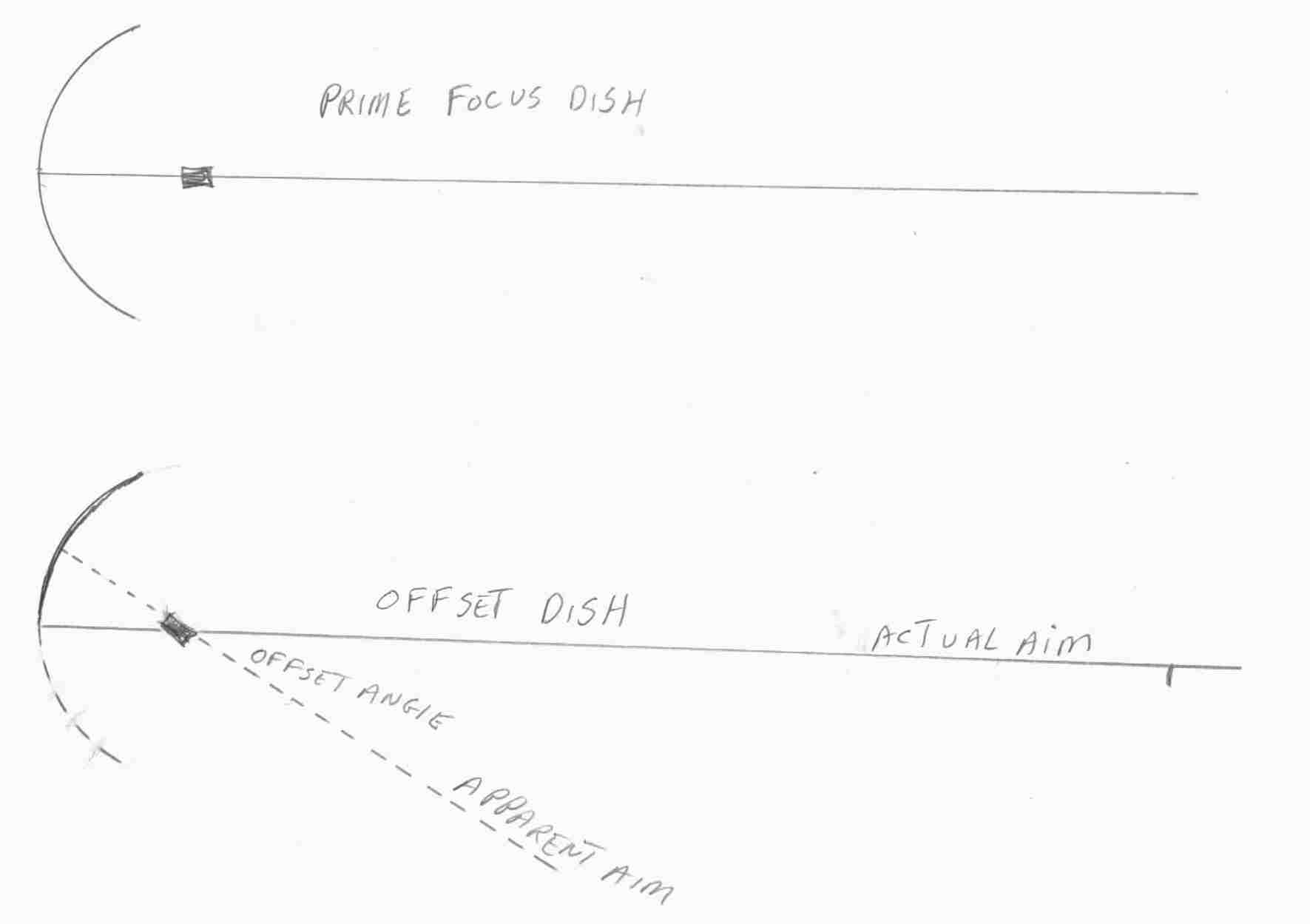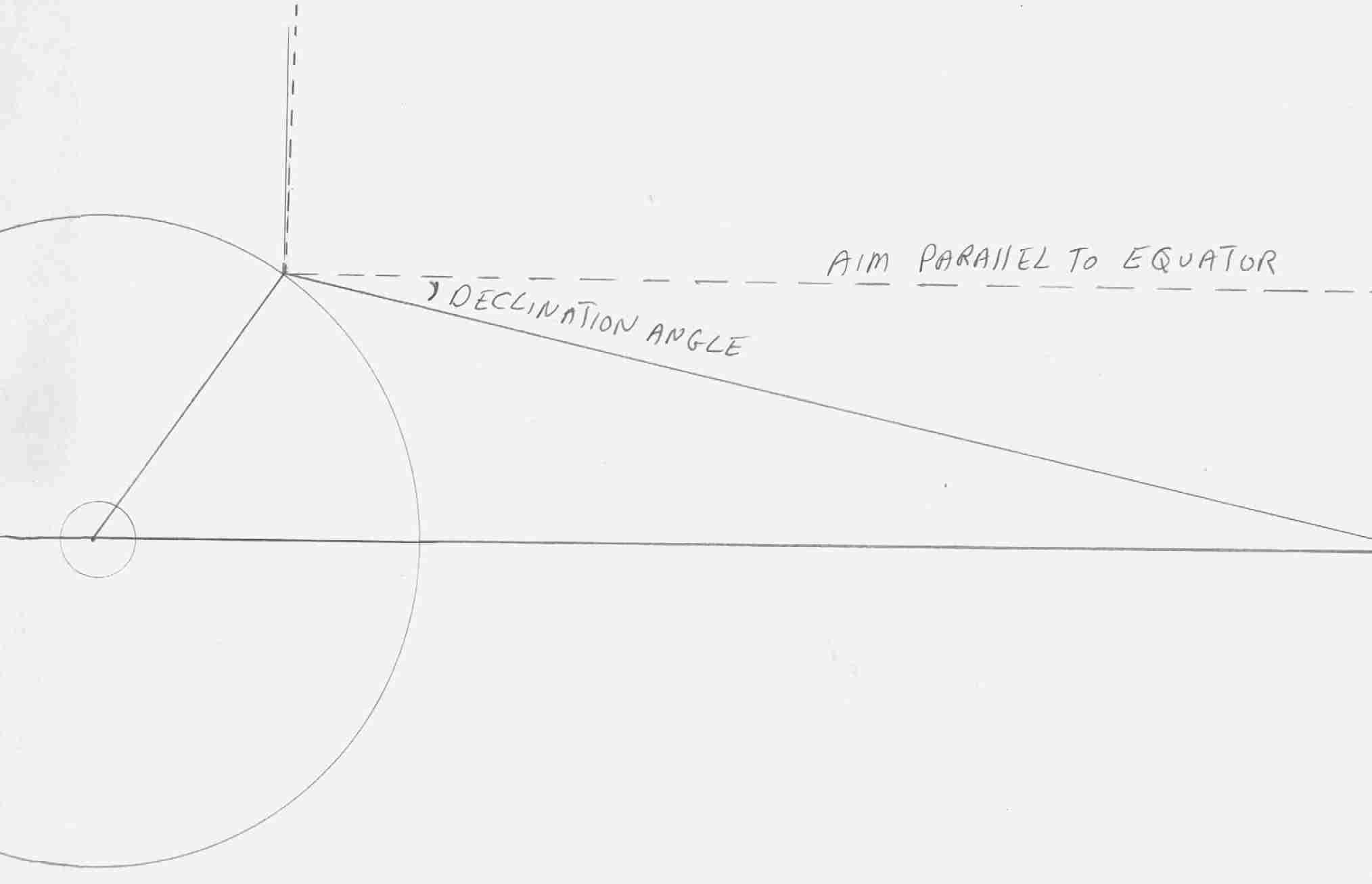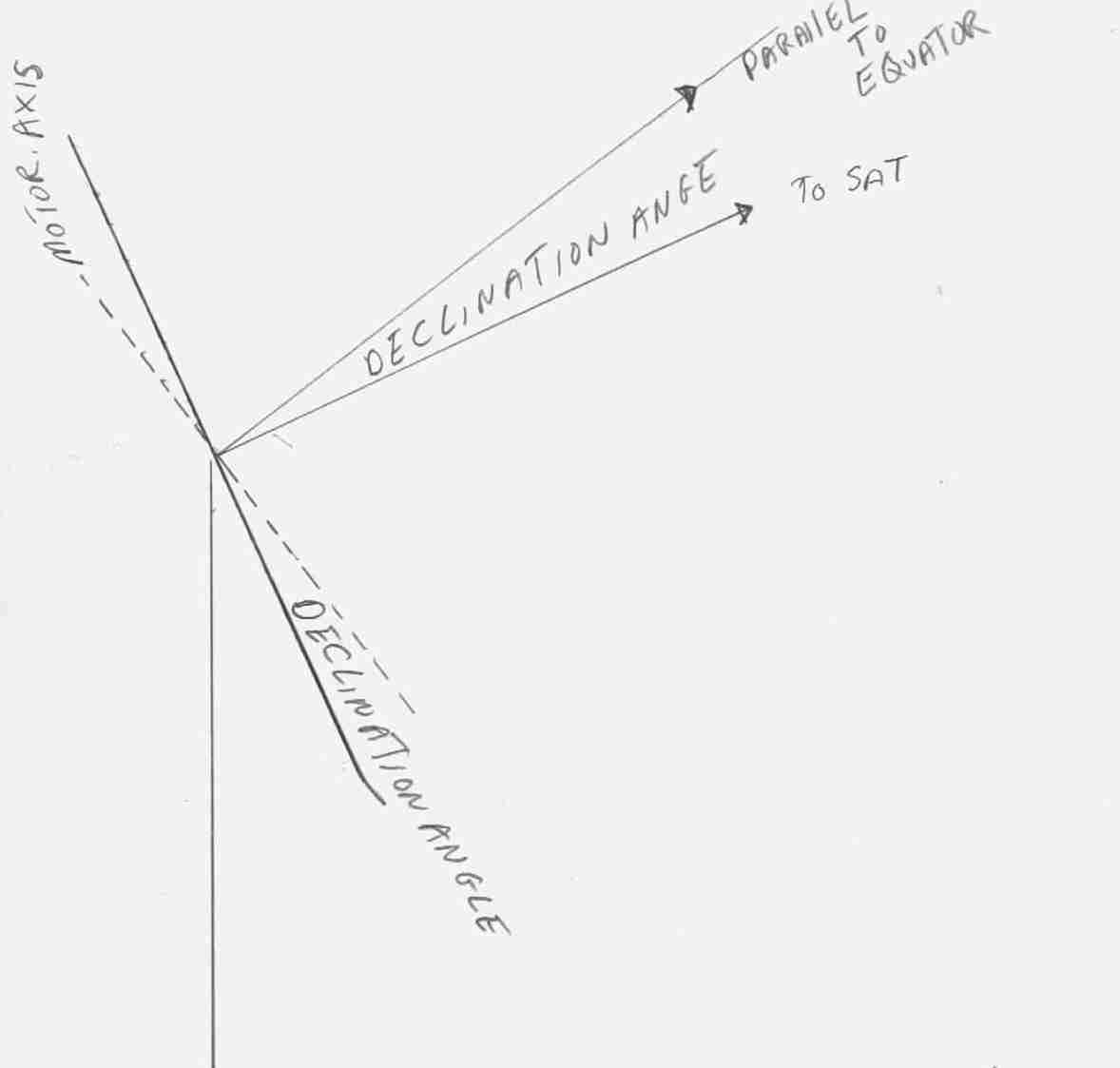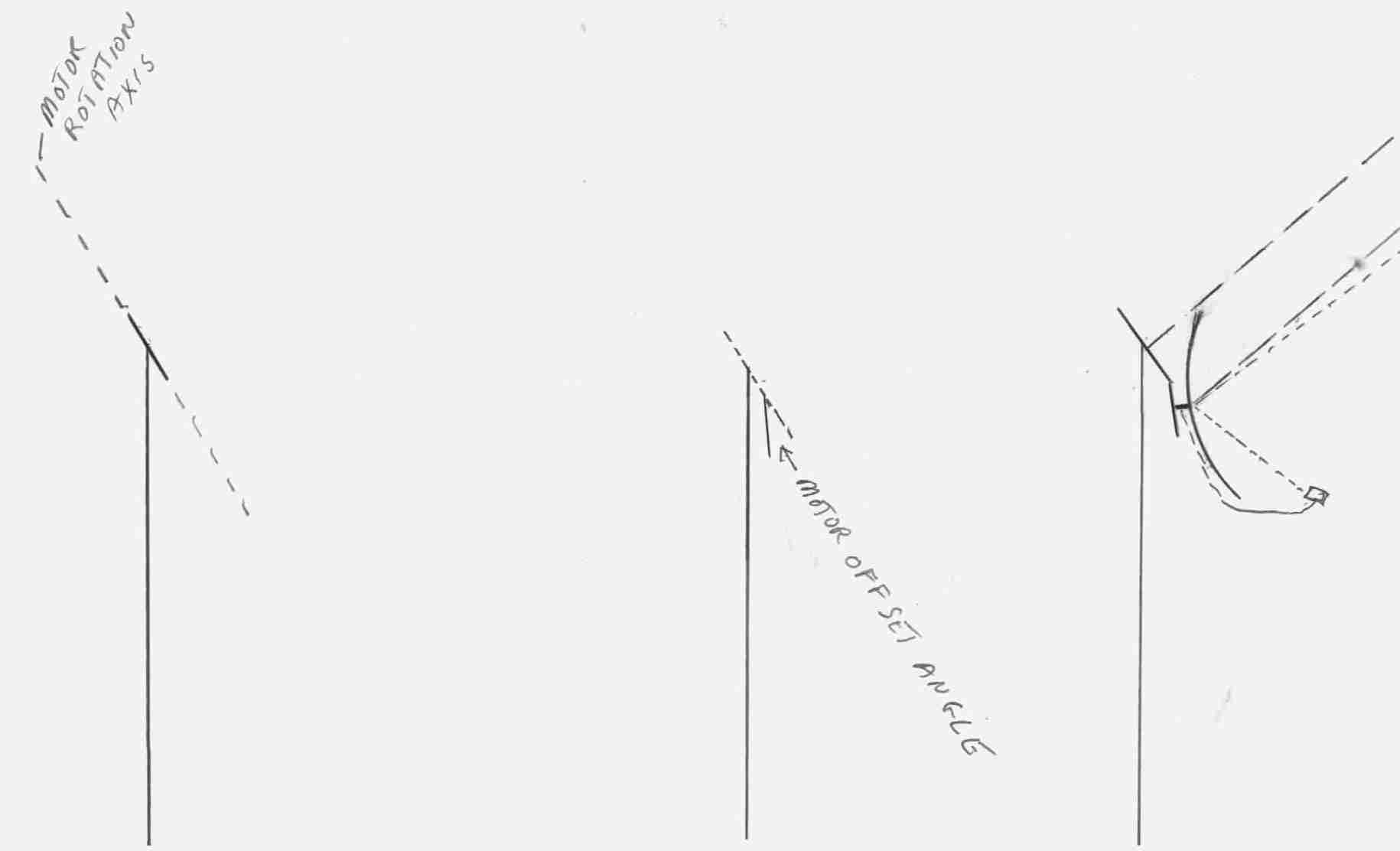Alignment
issues pertaining to small motorized offset systems.
I
would first recommend reading and understanding the previous link
pertaining to alignment of TVRO systems, ie How to align a
TVRO dish . Basically, the
exact same principles apply, no matter what kind of dish and motor you
have, unless it is a motorized Az/El system. Also, because small
offset dish systems, are considerably more forgiving than a big 10'
dish, it is really significantly easier to align a small dish than it
is to align a big dish. This is because for KU on a 10' dish, you
typically have to be accurate to within about 1/2 degree or better,
however with a 3' dish the requirred accuracy is closer to 2 degrees,
so measurements aren't as critical. This becomes apparent, when
you look at some of the installation pages put up by dealers, such as
the Sadoun page, which is one of the better ones, ie http://www.sadoun.com/Sat/Installation/HH-mount-installation.htm
. In this, and other dealer/manufacturer sites, they basically
ignore the 0.6 degree adjustment for the differences in declination
across the arc, simply because that 0.6 degree error just isn't that
important with a small dish. So small dishes are really easier to
align than big dishes.
HOWEVER...... the problem with small offset
dishes, is that since they are OFFSET dishes, they don't aim
where they seem to be aiming, and there typically aren't any flat
surfaces either parallel or perpendicular to the dish aim on which to
obtain an angle measurement with an inclinometer. Because of
this, you often have to rely on the angle scales printed on the side of
dish mounts, and the motor mounts, and these scales are sometimes
inaccurate, and sometime the scale for a different dish.
First, relative to the offset dishes not aiming
where they seem, the following (poor) drawing attempts to show this:

From the above, you see that an offset dish is really just part
of a prime focus dish, ie the dashed line represents part of the
parabolic surface that is missing. Also, the LNBF is tilted up to
the dish that is actually there, rather than aiming at the center of
the paraboloid. The reason for the use of offset design for small
dishes, is because in these offset dishes, the LNBF does not cast a
shadow on the dish surface. As a rule of thumb, the actual center
of the parabola is close to the near side of the dish, as shown in the
drawing above. The offset angles for small dishes can vary quite
widely. For example:
| Fortec - 65 |
24.62 |
| Fortec-80 |
22.75 |
| Fortec - 90 |
24.62 |
| Fortec 100 |
24.62 |
| Winegard-DS-3100-100cm |
24 |
| Winegard-DS-2076-76cm |
24 |
| Patriot-PTX-76 |
26 |
| Patriot-90 |
21 |
| Patriot-PTX-90 |
26 |
| Patriot-100 |
22 |
| Circular-DTV-18" |
22.5 |
| Dishnet-circular-18" |
22.5 |
| KTI-18" |
24.62 |
| Azure Shine
90cm |
24.62 |
| SignalMax-65 ? |
28 |
| SignalMax-85 ? |
26.6 |
| Channel Master |
???? |
| PARACLIPSE
Millennium 90 |
22 |
| GEOSATpro
90cm |
24.62 |
| GEOSATpro 1.2M |
27.3 |
In any polar TVRO mount, the motor shaft rotation axis
should be approximately parallel to the earth's rotation axis.

If the dish aimed perpindicular to this rotation axis, it would aim
parallel to the equatorial plane that the sats are in, and would miss
the satellites. This is why we need a "declination" angle, so
that we can aim down to where the sats are.

In a small motorized offset system, the motor rotation axis is
adjusted just as in a big dish system, so that it's axis is
approximately parallel to the earth's axis, ie tilted just forward of
being aimed at the north star. When a small offset dish is
attached to this motor axis, however, we need to tilt the dish down, by
the declination angle. Using the dishes own elevation scale, this
would correspond to an elevation of somewhere aroung -6 degrees (since
most declinations in the US are in the range of 5-6 degrees).
However, the elevation scales on small dishes do NOT go negative.
In fact, few of them even go close to zero. So how do we
adjust the declination of a small dish, when the adjustments don't go
negative? The answer is, that the motor shafts on the small dish motors
is usually bent. See middle picture below. If you attach
your dish to the lower bent portion of the motor shaft, you are tilting
the dish down by this angle, and this angle along with the setting on
your dish elevation scale combine to give you your declination.

For example some popular mounts have the following shaft offset angles:
| Motor |
HH90 |
HH100 HH120 |
Pansat PM900 S |
Moteck SG2100 |
| shaft angle |
45 |
30 |
46.5 |
30 |
| dish elevation adjust |
45-declination |
30-declination |
46.5-declination |
30-declination |
So you see, that you
basically subtract your declination angle from the motor shaft angle to
calculate the ideal angle for your dish elevation. One
warning, however.... some dish mounts have an elevation scale,
some dish mounts instead have a latitude scale, which is approximately
90 minus the elevation, and some dish mounts have both. The same
is true for motor mounts. So you must be careful to use the
proper scale, and if your mount doesn't have the scale you need, then
you need to subtract from 90 as appropriate.
When aligning a big dish, most people first adjust
the declination, by whatever means the dish mount provides, the this
adjustment is left alone, and never touched again, and the motor
elevation is adjusted by peaking on your due south satellite.
This is quite accurate. However, with small offset dishes,
because the adjustment scales are not very accurate, and/or confused,
most people instead first adjust their motor mount to the setting
appropriate to their latitude. Then they peak on their south satellite
by changing the dish elevation adjustment, which will effectively
adjust the declination.
ANYWAY, the steps to align a small offset dish are as follows:
1) Orient your motor so that it is aligned with your TRUE
SOUTH. I advise using the USNA web page to find the time
that the sun is at 180 deg, and use shadows on your mount to find true
south. If you use a compass, you need to be careful to use the
proper magnetic deviation for your location. Both of these
processes are described at the previous page on this site, ie http://www.megalink.net/~wejones/inst&align.html
2) SET THE MOTOR AXIS ANGLE TO YOUR LATITUDE, OR MORE PRECISELY 0.6 DEG
MORE THAN YOUR LATITUDE.
3) FIND YOUR TRUE SOUTH SATELLITE USING THE DISH ELEVATION SETTING, AND
PEAK THE SIGNAL USING BOTH THE DISH ELEVATION, MOTORING THROUGH THE
SAT, AND ROTATING THE MOUNT VERY SLIGHTLY ON THE POLE. (this last step
can be ommitted) Once you have done this, and have peaked on
your south sat, DON'T change this adjustment again.
4) USING THE MOTOR, MOTOR OVER THE MOST EXTREME SATELLITE YOU CAN
FIND, NEAREST THE HORIZON. (WHICHEVER DIRECTION IS MOST EXTREME
FOR YOU, IE IN THE EAST, FIND THE SAT FURTHEST WEST, AND IF YOU ARE IN
THE WEST FIND YOUR EASTMOST SAT.)
5) PEAK THE SIGNAL ON THIS SATELLITE, BY FIRST MAKING A VERY SMALL
ROTATION OF THE MOUNT ON THE POLE, THEN MOTOR BACK AND FORTH THROUGH
THE SAT TO SEE IF YOU HAVE IMPROVED THE SIGNAL. IF THE SIGNAL HAS
GOTTEN WORSE, ROTATE THE MOUNT IN THE OPPOSITE DIRECTION.
6) REPEAT #5 MAKING EVER SMALLER CORRECTIONS, UNTIL YOU HAVE THE BEST
SIGNAL POSSIBLE.
7) IF 5 AND 6 WERE NOT DONE ON YOUR FURTHEST WEST OR EAST SATELLITE,
YOU CAN NOW FIND YOUR FURTHEST WEST OR EAST SATELLITE, AND REPEAT 5 AND
6. ONCE YOU HAVE DONE 5 AND 6 ON YOUR MOST EXTREME
SATELLITE.......... YOU ARE DONE ........
In actuality, I should have said 95% of the time
you will be done at this point. Exceptions are if (1) your pole
isn't plumb (2) you have made an error in setting your motor's latitude
adjustment. But if you have been fairly careful with the initial
adjustments, then I would really recommend not trying to do further
fine adjustment, unless you are absolutely convinced that something is
wrong with your tracking. To tell if you need further adjustment,
motor in the opposite direction from where you made your extreme
adjustments. Ie if you adjusted on your far west sat, motor to the
furthest east sat you can find, and see if the reception is acceptable.
You can try lifting or pulling down on the dish to see if it makes the
signal better or worse.
The procedures for doing more fine adjustment than the
above are so complicated and time consuming, that instead of proceeding
that way, I generally just take more care going through the above steps
again, as I believe that you will generally make things worse
otherwise. However, if you want to try, one procedure for making
fine adjustments to the above can be found at:
http://www.satsig.net/polmount.htm .
Sorry for the poor graphics above. This web page is just
something I threw together to help people align their dishes, and I
didn't have time to create pretty graphics. :-)
FURTHER COMMENTS:
For ANY procedure for aligning a sat dish, you need
to be able to "peak" your signal. To do this you need some form
of a signal meter. With an old analog system, this signal
evaluation could be finding an analog video signal, and tune for
maximum signal strength and the fewest sparklies in the picture,
etc. However with the switch to digital, it has proven necessary
to find other means of finding and evaluating the signal
strength. Basically, there are many different choices here.
One way is to just use the signal meter on your receiver. The
problem here is first of all, this means taking your receiver and TV
out to the dish, and also that the signal meters on digital receivers
typically have a long delay, perhaps 5 seconds or more before they
respond to changes.
Another possible choice is to use one of the very
inexpensive hand held signal meters available at various vendors.
The problem with these, is that they are not very sensitive. You
need a fairly strong signal to get a reading with these. However,
if you are careful, these meters can be used effectively. I
usually connect the meter very close to the dish, and adjust the knob
so that it has a mid scale reading and a medium pitch. Then as
you peak the satellite you can see the meter go up and the pitch go
up. Some people have a hard time using these cheap meters.
I have had fairly good luck with them.
Another method is to acquire an old analog receiver which
has a "meter" port on the back. Connect this to your dish, and
connect a voltmeter to the meter port, then put the receiver into cycle
mode. Ie most receivers have a mode where they will cycle through
all the channels. Watch the meter as you move your dish, and when
you see it start to respond, stop the receiver on the channel giving
you a response, and further fine tune the dish.
At this point, however, you must connect your digital
receiver again, and identify the satellite by locking on known
transponders, to make sure that you are on the right satellite.
Anyway, the above is a quick description of the alignment
process. Overall, this is the same as for big dishes, but is just
complicated by the offset nature of these small dishes. But if
you are very careful with respect to the initial steps, the process
should really be easier than it is for a big dish.
GOOD LUCK.



